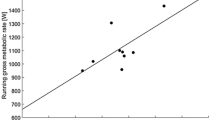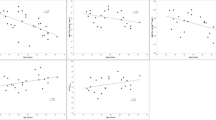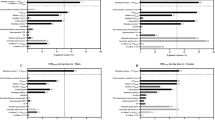Abstract
Introduction
Locomotive efficiency is cited as an important component to endurance performance; however, inconsistent observations of age-related changes in efficiency question its influence in the performance of masters athletes.
Purpose
This study examined locomotive efficiency in young and masters triathletes during both a run and cycle test.
Methods
Twenty young (28.5 ± 2.6 years) and 20 masters (59.8 ± 1.3 years) triathletes completed an incremental cycling and running test to determine maximal aerobic consumption (VO2max) and the first ventilatory threshold (VT1). Participants then completed 10-min submaximal running and cycling tests at VT1 during which locomotive efficiency was calculated from expired ventilation. Additionally, body fat percentage was determined using skin-fold assessment.
Results
During the cycle and run, VO2max was lower in the masters (48.3 ± 5.4 and 49.6 ± 4.8 ml kg−1 min−1, respectively) compared with young (61.6 ± 5.7 and 62.4 ± 5.2 ml kg−1 min−1, respectively) cohort. Maximal running speed and the cycling power output corresponding to VO2max were also lower in the masters (15.1 ± 0.8 km h−1 and 318.6 ± 26.0 W) compared with the young (19.5 ± 1.3 km h−1 and 383.6 ± 35.0 W) cohort. Cycling efficiency was lower (−11.2 %) in the masters compared with young cohort. Similar results were observed for the energy cost of running (+10.8 %); however, when scaled to lean body mass, changes were more pronounced during the run (+22.1 %).
Conclusions
Within trained triathletes, ageing can influence efficiency in both the run and cycle discipline. While disregarded in the past, efficiency should be considered in research examining performance in ageing athletes.
Similar content being viewed by others
Abbreviations
- MAS:
-
Maximal aerobic speed
- MAP:
-
Maximal aerobic power
- VO2 :
-
Oxygen consumption
- VO2max :
-
Maximal aerobic consumption
- VT1 :
-
First ventilatory threshold
References
Allen WK, Seals DR, Hurley BF, Ehsani AA, Hagberg JM (1985) Lactate threshold and distance-running performance in young and older endurance athletes. J Appl Physiol 58(4):1281–1284
Arampatzis A, Degens H, Baltzopoulos V, Rittweger J (2011) Why do older sprinters reach the finish line later? Exerc Sport Sci Rev 39(1):18–22. doi:10.1097/JES.0b013e318201efe0
Bernard T, Sultana F, Lepers R, Hausswirth C, Brisswalter J (2010) Age-related decline in olympic triathlon performance: effect of locomotion mode. Exp Aging Res 36(1):64–78. doi:10.1080/03610730903418620
Brisswalter J, Nosaka K (2013) Neuromuscular factors associated with decline in long-distance running performance in master athletes. Sports Med 43(1):51–63. doi:10.1007/s40279-012-0006-9
Brisswalter J, Tartaruga MP (2014) Comparison of COSMED’S FitMate and K4b2 metabolic systems reliability during graded cycling exercise. Scand J Clin Lab Invest 74(8):722–724. doi:10.3109/00365513.2014.930711
Brisswalter J, Wu SS, Sultana F, Bernard T, Abbiss CR (2014) Age difference in efficiency of locomotion and maximal power output in well-trained triathletes. Eur J Appl Physiol 114(12):2579–2586. doi:10.1007/s00421-014-2977-8
Cavagna GA, Legramandi MA, Peyre-Tartaruga LA (2008) Old men running: mechanical work and elastic bounce. Proc Biol Sci 275(1633):411–418. doi:10.1098/rspb.2007.1288
Coyle EF (2005) Improved muscular efficiency displayed as Tour de France champion matures. J Appl Physiol 98(6):2191–2196. doi:10.1152/japplphysiol.00216.2005
di Prampero PE (1986) The energy cost of human locomotion on land and in water. Int J Sports Med 7(2):55–72. doi:10.1055/s-2008-1025736
Duffield R, Dawson B, Pinnington HC, Wong P (2004) Accuracy and reliability of a Cosmed K4b2 portable gas analysis system. J Sci Med Sport 7(1):11–22
Evans SL, Davy KP, Stevenson ET, Seals DR (1995) Physiological determinants of 10-km performance in highly trained female runners of different ages. J Appl Physiol (1985) 78(5):1931–1941
Foster C, Lucia A (2007) Running economy : the forgotten factor in elite performance. Sports Med 37(4–5):316–319
Gaesser GA, Brooks GA (1975) Muscular efficiency during steady-rate exercise: effects of speed and work rate. J Appl Physiol 38(6):1132–1139
Gaesser GA, Poole DC (1996) The slow component of oxygen uptake kinetics in humans. Exerc Sport Sci Rev 24:35–71
Howe CC, Matzko RO, Piaser F, Pitsiladis YP, Easton C (2014) Stability of the K4b(2) portable metabolic analyser during rest, walking and running. J Sports Sci 32(2):157–163. doi:10.1080/02640414.2013.812231
Jones PR, Pearson J (1969) Anthropometric determination of leg fat and muscle plus bone volumes in young male and female adults. J Physiol 204(2):63P–66P
Kram R, Taylor CR (1990) Energetics of running: a new perspective. Nature 346(6281):265–267. doi:10.1038/346265a0
Lacour JR, Bourdin M (2015) Factors affecting the energy cost of level running at submaximal speed. Eur J Appl Physiol 115(4):651–673. doi:10.1007/s00421-015-3115-y
Lepers R, Sultana F, Bernard T, Hausswirth C, Brisswalter J (2010) Age-related changes in triathlon performances. Int J Sports Med 31(4):251–256. doi:10.1055/s-0029-1243647
Lepers R, Knechtle B, Stapley PJ (2013) Trends in triathlon performance: effects of sex and age. Sports Med 43(9):851–863. doi:10.1007/s40279-013-0067-4
Louis J, Hausswirth C, Easthope C, Brisswalter J (2012) Strength training improves cycling efficiency in master endurance athletes. Eur J Appl Physiol 112(2):631–640. doi:10.1007/s00421-011-2013-1
Maharam LG, Bauman PA, Kalman D, Skolnik H, Perle SM (1999) Masters athletes: factors affecting performance. Sports Med 28(4):273–285
Narici MV, Maffulli N, Maganaris CN (2008) Ageing of human muscles and tendons. Disabil Rehabil 30(20–22):1548–1554. doi:10.1080/09638280701831058
Peiffer JJ, Abbiss CR, Chapman D, Laursen PB, Parker DL (2008) Physiological characteristics of masters-level cyclists. J Strength Cond Res 22(5):1434–1440. doi:10.1519/JSC.0b013e318181a0d2
Porter C et al (2015) Mitochondrial respiratory capacity and coupling control decline with age in human skeletal muscle. Am J Physiol Endocrinol Metab:ajpendo 00125:02015. doi:10.1152/ajpendo.00125.2015
Reaburn P, Dascombe B (2008) Endurance performance in masters athletes. Eur Rev Aging Phys Act 5(1):31–42
Rust CA, Lepers R, Stiefel M, Rosemann T, Knechtle B (2013) Performance in Olympic triathlon: changes in performance of elite female and male triathletes in the ITU World Triathlon Series from 2009 to 2012. Springerplus. doi:10.1186/2193-1801-2-685
Sacchetti M, Lenti M, Di Palumbo AS, De Vito G (2010) Different effect of cadence on cycling efficiency between young and older cyclists. Med Sci Sports Exerc 42(11):2128–2133. doi:10.1249/MSS.0b013e3181e05526
Santos DA et al (2014) Reference values for body composition and anthropometric measurements in athletes. PLoS One 9(5):e97846. doi:10.1371/journal.pone.0097846
Saunders PU, Pyne DB, Telford RD, Hawley JA (2004) Factors affecting running economy in trained distance runners. Sports Med 34(7):465–485
Short KR, Bigelow ML, Kahl J, Singh R, Coenen-Schimke J, Raghavakaimal S, Nair KS (2005) Decline in skeletal muscle mitochondrial function with aging in humans. Proc Natl Acad Sci USA 102(15):5618–5623. doi:10.1073/pnas.0501559102
Sultana F, Abbiss CR, Louis J, Bernard T, Hausswirth C, Brisswalter J (2012) Age-related changes in cardio-respiratory responses and muscular performance following an Olympic triathlon in well-trained triathletes. Eur J Appl Physiol 112(4):1549–1556. doi:10.1007/s00421-011-2115-9
Sunde A, Storen O, Bjerkaas M, Larsen MH, Hoff J, Helgerud J (2010) Maximal strength training improves cycling economy in competitive cyclists. J Strength Cond Res 24(8):2157–2165. doi:10.1519/JSC.0b013e3181aeb16a
Tanaka H, Seals DR (2003) Invited review: dynamic exercise performance in masters athletes: insight into the effects of primary human aging on physiological functional capacity. J Appl Physiol 95(5):2152–2162. doi:10.1152/japplphysiol.00320.2003
Tanaka H, Seals DR (2008) Endurance exercise performance in masters athletes: age-associated changes and underlying physiological mechanisms. J Physiol 586(1):55–63. doi:10.1113/jphysiol.2007.141879
Trappe SW, Costill DL, Vukovich MD, Jones J, Melham T (1996) Aging among elite distance runners: a 22-yr longitudinal study. J Appl Physiol (1985) 80(1):285–290
Verdijk LB, Koopman R, Schaart G, Meijer K, Savelberg HH, van Loon LJ (2007) Satellite cell content is specifically reduced in type II skeletal muscle fibers in the elderly. Am J Physiol Endocrinol Metab 292(1):E151–E157. doi:10.1152/ajpendo.00278.2006
Wasserman K, Whipp BJ, Koyl SN, Beaver WL (1973) Anaerobic threshold and respiratory gas exchange during exercise. J Appl Physiol 35(2):236–243
Whipp BJ (1994) The slow component of O2 uptake kinetics during heavy exercise. Med Sci Sports Exerc 26(11):1319–1326
Author information
Authors and Affiliations
Corresponding author
Ethics declarations
Conflict of interest
The authors have disclosed that they have no significant relationships with, or financial interest in, any commercial companies pertaining to this article. No funding was received for this work.
Additional information
Communicated by Jean-René Lacour.
Rights and permissions
About this article
Cite this article
Peiffer, J., Abbiss, C.R., Sultana, F. et al. Comparison of the influence of age on cycling efficiency and the energy cost of running in well-trained triathletes. Eur J Appl Physiol 116, 195–201 (2016). https://doi.org/10.1007/s00421-015-3264-z
Received:
Accepted:
Published:
Issue Date:
DOI: https://doi.org/10.1007/s00421-015-3264-z




